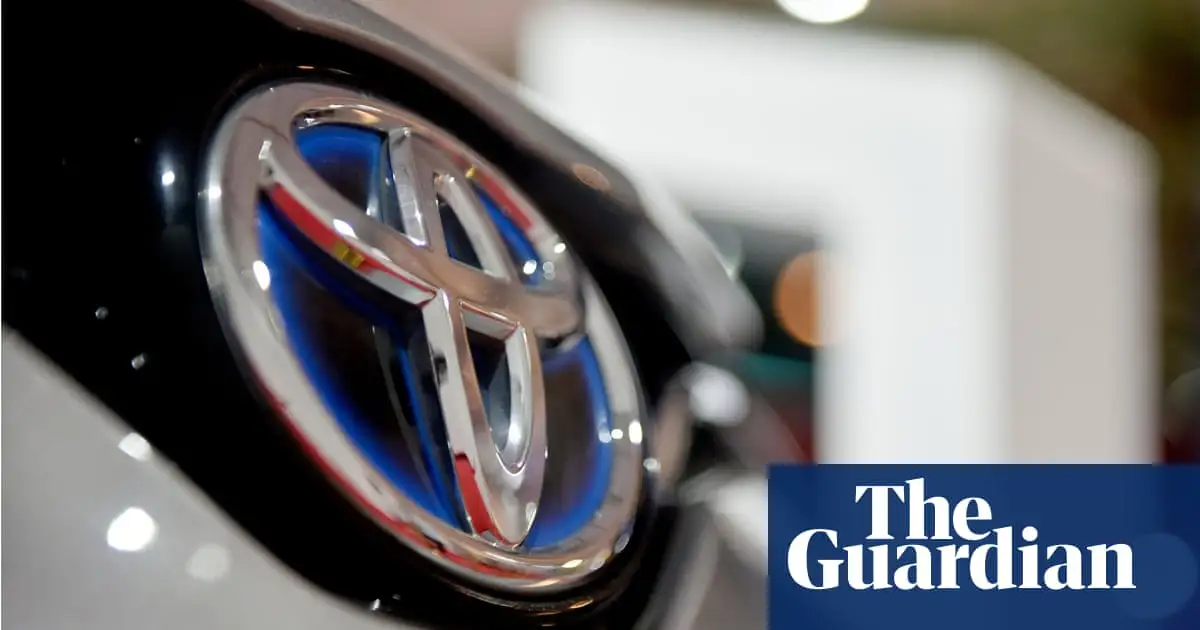Japanese firm believes it could make a solid-state battery with a range of 745 miles that charges in 10 minutes
They have been “claiming”/ “announcing” this breakthrough since 2017 repeatedly. They STILL haven’t figured out how to mass produce it affordably to making it meaningful. They keep pushing out the date for when it will arrive for many years now.

- Release statement claiming breakthrough
- Attract investment money
- Run out of money
- Release statement claiming breakthrough
- Attract investment money
- Run out of money
Repeat until product is complete or no one will invest.
I “”“claim”“” the planet Jupiter
I “”“claim”“” the planet Jupiter
deleted by creator
Since Toyota is way ahead with hybrids but behind with EVs, this would be a way to tell the public, “wait, don’t buy a competitor’s EV, because we’ll have something 100x better in a year or so.”
I hope I’m just being cynical, because solid state batteries do sound awesome. I wonder was the weight difference would be
Oh fuck off with that charging times.
Assuming this battery will be 150kwh (which is a conservative estimate for such a range)
Let’s ignore even heat loss So you need to 150kwh in 10 minutes, wish equals to 900kw of immediate charging speed.
Now imagine 20 of those power inputs connecting/disconnecting on a local power management substation.
Not fucking gonna happen.
Basically every other fast charge time is quoted from 0-80% or 20-80%, something like that. So it’s probably capable of around 600kw charging. I don’t think we have chargers that fast, but maybe you could plug in 2x 350kw chargers in at the same time, lol
Even if the power load on the grid was doable, heat dissipation is also a huge problem. Current DC fast chargers max out at 350 kW (in theory, my car supports charging at that rate but the best I’ve seen in real life is around 190kW), and the liquid-cooled cables are already heavy/bulky enough to give some women and older folks a hard time. I can’t imagine a practical way to handle 2 or 3 times the current without making the cables something like 6 inches in diameter and weighing a couple hundred pounds.
Tbh cable heat dissipation is not really a problem if you increase battery voltage, which those solid state batteries have theorically no problem doing. To keep current cable we would need 3200v batterie, which I could see happening.
I’ve wanted to believe in breakthrough battery technology so many times and been let down. I’ll wait until it hits the market before getting excited. Even this article is pretty vapor-ish:
The world’s second largest carmaker was already pursuing a plan to roll out cars with advanced solid-state batteries, which offer benefits compared with liquid-based batteries, by 2025.
Then a little further down:
The company expects to be able to manufacture solid-state batteries for use in electric vehicles as soon as 2027
I’m waiting for the,“By 2030 we’ll definitely be able to use these batteries in our 2035 models. You’ll see this in 2040 and the sky will open up with sunshine and birds will sing.”
all the technology you enjoy today was breakthrough not too long ago
And typically real breakthroughs of this magnitude are announced with more polish than a throwaway guardian article.
Surprisingly not always, many aren’t announced at all. i wouldn’t hold my breath on this coming out soon though, no.
People in Africa age a day every day.
last year it recalled 2,700 of its first electric vehicles because of concerns the wheels could fall off.
I set up the production line for this hub unit. This news has been really annoying because it meant we had to scramble to install a bolt press machine on this line.
It sounds like you’re implying you wouldn’t have had to install it without this news breaking. Is that the case? I’m curious about this topic if you care to elaborate. What is a bolt press machine? How has this news affected you?
I am hoping it is more of a “they should have seen this coming” kind of thing. In such a way that they should have had ample time before the line was made active to install it.
To clarify, the line had not been handed to production yet. However, a change like this takes time. A typical new program launch takes something like 2 years between initial request to start of production. Obviously, sourcing and integrating one machine doesn’t take that long. But any new part requires that every machine be re-evaluated for quality on that new part and the line as a whole needs to be re-tested. Even if the design change is small.
When they engineer cars, they try to make them as cheap as possible. In all likelihood, they knew of the risk at the time of engineering but thought it low enough to go ahead to production. Post production, they probably found a an overlooked circumstance that would cause failure, one that is common enough that it would cause costly wrongful death lawsuits. Then they decided on a recall.
There are plenty of “known issues” with current vehicles on the road today but they are calculated to occur infrequently enough that the car companies won’t get class action suits, and the one off wrongful death suits they do get will be few enough so as to be calculated into the cost of doing business.
Somehow, I still enjoy driving.
Just to expand on this: a car company doesn’t do the detail design for supplied components. They give general requirements like loads, lifespan, and specs about mating surfaces, but the supplier has more knowledge about designing their products than the car company. However, the car company can still override the supplier’s advice or decisions about design characteristics. They are the customer, after all.
TIL. Thanks!
A bolt press is what it sounds like. It presses the studs into the hub unit (idk why we call studs bolts). I think we, as a company, knew about it before the news broke. We had to re-configure the line to add a machine that wasn’t there originally and now we need to changeover between the bolt-type and bolt-less. This changeover is more involved than you might think since some of the components were redesigned for the bolt-type, necessitating some new tooling.
So long the front doesn’t fall off… https://www.youtube.com/watch?v=gWPwlMv8lNI
Please, for the love of god, leave that joke on Reddit.
I apologize. That joke continues to crack me up and I feel compelled to share.
Were you not pressing in the studs?
The original hub unit just had threaded holes. While we were installing the line and getting it tested, a wheel fell off one of the EV cars using this hub. This meant we had to source and install a bolt-press machine (we call them bolts, not studs, idk why) and make other changes to accommodate that. We’re still making the threaded hole version for the platforms where this isn’t an issue. But now the line needs to changeover periodically to run different parts with pressed studs. This adds complexity and downtime which is never great.
I’ve never seen a stud threaded into a hub. I do own car with lug bolts though. Very odd choice considering it requires extra machine processes required to manufacture that. It would be interesting to know why they felt the need to do it that way.
It’s as you described. For some reason, studs are called bolts at this company. So a bolt press is a stud press. The design change went from a hub with threaded holes for lug bolts, to a hub with pressed studs. There were some other design changes as well but that was the main one.
I bought the Subaru version and lost tax credit because of the delays from this thing. Fun times.
The quickest way I’ve found to separate the articles that are going to be meaningless waste-of-time fluff pieces from ones that might be informative is to find the verb in the headline.
Is it something like “claims”, “calls for”, “praises”, “criticizes”, or “expects”? Fluff. If something deserving of a more concrete, direct verb had happened, the headline would have said so. Verbs like “slams” or “attacks” or “demands” are even worse; they’re aggressive and enthusiastic about their content but still can’t make the claim something actually happened or changed.
If the verb is preceded by “could”, “might”, “maybe”, or similar, especially with regard to tech news, it’s also probably an empty slow-news-day article, but those words aren’t necessarily as hollow as the ones mentioned above. Sometimes they’ll contain interesting information about the current state of things, even if they’re just going to lead you on a merry speculation romp about the optimistic/horrifying future.
deleted by creator
Why do you feel hydrogen is the future?
From my understanding, it’s more of a fuel than a storage medium so they kind of play different roles. On top of that, I thought it’s currently pretty difficult to store outside of pretty extreme conditions and the best way to create it at the moment is by burning fossil fuels (natural gas).
I’m not an expert, so let me know if I got any of that wrong!
TL;DR: You’re correct, in my professional opinion.
The catalyst in most hydrogen fuel cells are still too expensive and have a limited life. Hydrogen will mostly be sourced as a waste product from oil and gas extraction (though it could be done with clean electricity and electrolysis), that’s why oil and gas companies are becoming so interested in pushing hydrogen (see the successful “clean” natural gas campaigns, but depending on how you measure it natural gas can result in more emissions than coal and is just a bunch of greenwashing. Same would happen with hydrogen in my opinion). Additionally, we’d have to build out an entire hydrogen delivery infrastructure that serves only that purpose. We’ll just end up with commercial fuel stations like we have now. Fuel cells (for many fuels) can make sense in very remote applications, or industrial applications where specific waste gasses can be turned into supplemental electricity right on site.
Battery-electric on the other hand is much more flexible and fits into our existing infrastructure better. It’s not just power dense batteries for cars; it’s (maybe gravity) batteries for communities, safe and long-lived (maybe salt) batteries for homes, better batteries for our electronics. Research in one area can support improvement of the others. They all connect to the same electricity grid so the energy can be shared among applications. Batteries play a role in decentralizing and democratizing energy (today you can put PV on your house, charge your car or home battery, use your car to power your house in a power outage, etc). As mentioned we can use greener and cleaner batteries (even completely non-chemical) in some applications, and one day we can hopefully get to the point of using ultra- or super-capacitors in place of high-density chemical batteries. In the mean time we have batteries that work and are getting quite affordable, we can transition to this solution now without waiting for a miracle breakthrough, then continue to iterate the technology over time.
Hydrogen… Isn’t really the future. It could be the future for Electricity Generation. But, for cars? No way Jose.
deleted by creator
I still remember graphene batteries being a thing for 10 years now, and the most we’ve gotten so far is GaN charging bricks. Methinks that companies just claim stuff like this to get shareholders excited.
The important question is what is so wrong with the now countless existing 200/300 mile evs that charge in less than 30 minutes?
300 miles isn’t enough distance for a day of travel and lots of places don’t have charger availability still. What’s wrong with approaching parity in user experience to gasoline vehicles? It will only accelerate their use, and 700 miles in winter is going to be only maybe 300 miles.
A 30 minute charge for every 4 hours of driving is already practical for a long drive. Every safety organisation and fatigue management plan on the planet says you need to stop more often than that for fatigue anyway.
If some is regularly driving more than 200mi/320km in a day (more than the average car drives in a week) without a break on those trips, then a hybrid car is probably a better bet for the foreseeable future.
- cars hold more than 1 person
- mountains mean that four hours is now three hours
- cold weather means that four hours is now two hours
- mountains plus cold weather means four hours is now one and a half hours
- much of the (us) country lacks charging stations to support that, or even the infrastructure to support the charging stations
- hybrid cars are the worst of both worlds
- 300 miles is just barely under the safe distance between most major towns \cities in parts of the us
- that means you barely or don’t get to your location on one charge
- current charging infrastructure means taking a couple hours extra on many trips right now. At least some of this is improving, but very slowly.
This is a very real problem. We know, we have family with an ev who need to travel to us to visit on occasion.
300 miles is just barely under the safe distance between most major towns \cities in parts of the us that means you barely or don’t get to your location on one charge
I’ve never owned a car in my life that gets more than 300 miles on a single tank of gas.
And there’s plenty of gas stations you can stop at to fill up in a few minutes.
What do you drive? A 2005 Honda civic gets 330+ miles on a full tank. Even a modern 4WD truck can hit 400+ miles total range.
My partner and I have owned an EV since 2017, so I am going to weigh in with my experiences.
cars hold more than 1 person
I think this is implying that you can rotate drivers without breaks to get more miles, and that is also not great. Yes, you’re stopping briefly to rotate seats, but that is not really a break unless you are taking a 15-30 minutes to nap or walk around a little bit. I’ve done this and it is not fun and does not feel like you have taken any breaks.
With the EV, we are forced to stop more on road trips, and we typically arrive feeling like we can actually do something rather than crash in the campsite/hotel. For reference, a road trip from Seattle to the middle of nowhere Idaho took a little longer, especially with a car that only had 180 miles of range, but the in the end we still got there in plenty of time and did not feel like going directly to bed.
mountains mean that four hours is now three hours
If you are going uphill only, yes. That being said, regeneration has got to the point where if you are going downhill, you’ll recoup most of that lost energy.
cold weather means that four hours is now two hours
This is not true at all. 50% range loss is not only not common, the top selling EVs get at most 30% range loss. Most are in the 15-20% loss range.
https://www.recurrentauto.com/research/winter-ev-range-loss
Basically, if you live or travel in an area with cold weather, make sure you get a car with a heat pump.
mountains plus cold weather means four hours is now one and a half hours
Again, if you are going uphill only in cold weather this is going to be closer to 2-2.5 hours based on this metric, but most people go up then down hills when driving.
much of the (us) country lacks charging stations to support that, or even the infrastructure to support the charging stations
This is absolutely the biggest issue. If you are sticking to the major highways you are usually fine, but more rural ares are seriously under served.
300 miles is just barely under the safe distance between most major towns \cities in parts of the us
Someone else already went into way more detail on this one, but I will absolutely agree that the rural US needs more infrastructure.
that means you barely or don’t get to your location on one charge
This can and does happen. Trip planning requires a bit more effort because of it for sure, but there are tools (A Better Route Planner and PlugShare) that can help. If you take a lot of trips, getting a Tesla Tap and making sure you get hotels with Tesla destination chargers helps a lot.
current charging infrastructure means taking a couple hours extra on many trips right now. At least some of this is improving, but very slowly.
This really depends on the DC fast charging ability of the car and the charging station infrastructure (which needs a ton of work). Most of the cars currently available have 150kWh fast charging, which will take you about 20-30 minutes per charge. With the Hyundai/Kia eGMP platform you can get 350kWh charging, which will take you about 15 minutes per charge if you get a 350kWh charging station. The only car I would not recommend if you road trip is a Chevy Bolt, which only has 50kWh DC fast charging.
For more info you should check out MKBHD’s video about road tripping against a gas car or Aging Wheels/Technology Connections video about road tripping with a Hyundai Ionic 5 (with 350kWh charging).
As an aside, as much as I hate Elon/think Teslas are not great cars, they are starting to open their charging network and big car companies are adopting their charging port. This will help a lot with infrastructure since they have one of the biggest networks in the US, and with an adapter you can use CCS chargers with a Tesla port, so you’re not loosing out on non-Tesla chargers.
I think this is implying that you can rotate drivers without breaks to get more miles
Yes. Because you can literally sleep the other two hours your other shift is driving. We do it regularly.
I’ve done this and it is not fun and does not feel like you have taken any breaks.
That’s unfortunate for you. Every single person I know does fine rotating drivers. Semis also do it all the time and it’s considered safe enough.
you’ll recoup most of that lost energy.
Unfortunately not because the primary energy losses come from aerodynamics not from the climb. So you can recover a decent amount, and the slower you go the more you can theoretically approach 99% recovery, but in practice this is not the case.
This is not true at all. 50% range loss is not only not common, the top selling EVs get at most 30% range loss. Most are in the 15-20% loss range.
🎶safety factors🎶
This really depends on the DC fast charging ability of the car
it was a comment on having to use alternate routes to stay charged, not on the actual duration of charging, which can potentially add up is still only around 20% added trip time.
Thank you for the links, I appreciate the thought but we have an EV in the family, most of what I’ve said here relates to safety and practical outcomes and considerations we’ve made and worst case scenarios. In other words we have already done road tripping ourselves.
The tesla charger was forced to be an open standard and is being adopted for practical reasons, which works out.
Yes. Because you can literally sleep the other two hours your other shift is driving. We do it regularly.
It is still not the same thing as taking a break. Some people can’t sleep in cars, most people don’t sleep well in cars. I’m glad you can. Just because you can does not mean most people can
That’s unfortunate for you. Every single person I know does fine rotating drivers. Semis also do it all the time and it’s considered safe enough.
Semis literally have beds in them. That is not the same as sleeping in a car
Unfortunately not because the primary energy losses come from aerodynamics not from the climb. So you can recover a decent amount, and the slower you go the more you can theoretically approach 99% recovery, but in practice this is not the case.
EVs take into account a ton of aero, and the aerodynamics don’t change going up or down hill. Also, in practice, regeneration going downhill does recuperate the range loss from going uphill. I have done it many, many times. Sometimes you even overcome range loss and end up with more than when you started if the descent is particularly steep, though that is much more rare.
🎶safety factors🎶
You keep saying safety factors, but it seems to be based on just a hunch
it was a comment on having to use alternate routes to stay charged, not on the actual duration of charging, which can potentially add up is still only around 20% added trip time.
That certainly can be a factor based on infrastructure. Again, we need a lot more out there
I appreciate the thought but we have an EV in the family, most of what I’ve said here relates to safety and practical outcomes and considerations we’ve made and worst case scenarios. In other words we have already done road tripping ourselves.
So do you have an EV or do you have family from out of town that does? You’ve kinda said both. Also, you have said you don’t want individual car arguments, but you seem to be basing everything on an individual car (the one in your family). The reality is the make/model of the car does make a difference, but it is becoming less and less of an issue as EV tech progresses, and a majority of them don’t have the issues you are concerned about. Unless you are road tripping in a gen 1 Leaf or Chevy Bolt, the concerns are more anxiety than anything.
My partner and I go camping a bunch (no charging stations in the bushes), road trip from Seattle down to Oregon quite a bit. Like I said, we have also done very long road trips, but those are more rare (as they are with most people). We have never run into an issue where the extra time was an issue, have never lost 40% range in the cold (with 3 different EVs), and have never had an issue with hills or mountains (again, we have always gone down the other side or back down the same way in the case of camping). Hell, we live in Seattle which is a steep city and my partner drives for work (75-100 miles/day) and have not run into these issues. I will say we are lucky to live on the west coast where the infrastructure is much better than other areas, but I have always agreed we need more infrastructure. Even so, now that we have a place to charge at night, we don’t use much of the local infrastructure (which is a privilege, I know).
More important than stuff we’ve been discussing (IMO, since most folks don’t actually road trip that much), I think more important things to argue for are infrastructure in rural areas, and infrastructure for people in apartments. Right now, not having a place to charge at night is a big barrier for most people in apartments. In rural areas, the distance between chargers is currently too high, though if folks have a place to charge at home, that is less of an issue for daily use.
It is still not the same thing as taking a break. Some people can’t sleep in cars, most people don’t sleep well in cars. I’m glad you can. Just because you can does not mean most people can
K. Different people have different experiences. Given I was responding to someone’s assumption that cars only transfer 1 person at a time over long distances, I’m going to say my response was pretty safely addressing this exact point. Feel free to disagree.
Semis literally have beds in them. That is not the same as sleeping in a car
True, and from personal experience the cars were more comfortable. Sleeper cabs are not that big.
You keep saying safety factors, but it seems to be based on just a hunch
See my other response.
You’ve kinda said both
Given one was explicit and the other is your inference this has been covered.
you seem to be basing everything on an individual car
Right, because I’m offering conservative estimates on the details using it to counter an anecdotal belief to point out that it’s not exactly as simple as the op was commenting on. This discussion is so far removed and so terminally reddit, christ.
Seattle down to Oregon
Something that is likely happening here is your definition of cold weather is not my definition of cold weather. Even the link I sent, which approaches 30%, barely touches below 20F. This is cold, sure, but not the most cold. Which when you are planning driving, you generally want to be able to drive in the worst conditions for your area so you don’t, you know, get stranded and/or die. Given temperatures in my area reach as low as -20F yearly you might benefit from reconsidering your assumptions.
more important things to argue for
These are entirely independent problems with independent research teams and are so removed from each other as “battery research” is obviously research, while “infrastructure every 50 miles” is political. These aren’t more or less important, they are entirely independent discussions.
This argument is so nitpicky and feels like bleed over from reddit. It’s not about anything useful, it’s about you misunderstanding the point I’m making and nitpicking the rhetoric until you’ve decided I’ve said something in a way you would have also said it, and therefore it is acceptable to you. I’m done here, have a good one.
300 miles is just barely under the safe distance between most major towns \cities in parts of the us
Improving range and charging infrastructure is certainly a good thing, especially when there are people who live in remote parts of the country and Americans do go on road trips from time to time. That said most people in the US inherently live in the more populous regions. Less than 300 miles can get you from LA to Las Vegas, and under 300 gets you NYC to DC and theres a number of population centers you cross along the way(obviously more on the east coast). A student traveling from Long Island NY to Buffalo NY will have to drive over 400 miles which is just out of range but there’s enough towns and cities on the way that they should be able to hit up a fast charger.
EV’s already have the disadvantage of being more expensive and and adding an extra 100 miles of capacity would likely add to production costs. So I understand why the major auto manufacturers are targetting 300 which will is far enough to get you into a place with a different dialect and climate. I believe the average trip in america winds up being closer to 50 miles anyway(though this is weighed down by americans making lots of short trips).
Also most of the compact cars I’ve owned have a range of around ~350-375. If I get a good back wind and the conditions are right I can possibly get up to 400 but thats up to Poseidon and he only does it sometimes to gaslight me into thinking my car is more efficient than it.
For people living in the more sparsely populated parts of the US I think sticking with petrol for longer trips or even an EV hybrid would be a good compromise. I imagine thanks to how somehow climate change has become political, that a large chunk of residents living in such rural parts of the country are anti-electric car anyway.
I hadn’t so much considered mountainous areas, since highway driving here is mostly flat (even what we consider “mountains” are pretty flat). Yes, we are going to need charging infrastructure on long drives, but that’s going to be the case even if batteries could do 500km or 1000km on a charge. My petrol hatchback can only do 500km highway, and there’s still servos every few 100km at a minimum, even through the most of the outback. We will need fast charging as commonly as we have highway servos.
But if you live in a place where the common long drives you do are ~1.5x your range, and have a charger halfway, an electric car is easily practical. Longer drives are practical, a mate did a 1600km round trip in their EV with no issues, and would gladly do it again.
As for hybrids, yeah, a plug-in hybrid is the worst of both, but a ‘normal’ hybrid is essentially just a very efficient petrol car.
I’ve got the 2021 Kona EV and while you do lose range in the winter, it’s more like 100km/450km. That’s with intense grip heavy winter tires and the heater running. In Ontario, so regularly ran it with -35c temps. It’s cold and you lose some range, but not 400miles out of a 700mile range
In general Li ion batteries lose about 40% charge efficiency in normal cold weather. It’s up to the car’s systems to keep the batteries heated to reduce that, at the cost of constant power draw. In our experience with similar weather it’s not far off, and for safety reasons we just assume half the battery is lost during winter driving. Mountains add into that, but aren’t ultimately super extreme.
Yes, but the power draw of those systems are less than the 40% figure you cited. Anyone who lives somewhere cold and doesn’t get a heat pump on their battery is stupid, and not a fair comparison. As I mentioned, the battery life is closer to losing 10% than 40% in real life tests of the vehicles, and that lines up with my experiences.
Kona Electric wins Norwegian real-range validation test
The Norwegian Automotive Federation (NAF) recently compared 20 EVs in cold and warm weather conditions to identify models with the most consistent driving range and charging performance. The test monitored the performance deviation of each vehicle in cold conditions compared to quoted manufacturer figures.
The Kona Electric took first place, travelling 405km in the cold – compared to the 449km quoted under WLTP combined cycle testing conditions (23°C / 73°F). In severe cold weather, the Kona Electric offered 91 percent of its WLTP combined cycle range, deviating just 9 percent from its claimed all-electric driving range.
Ultimately depends on the car and the engineering. You’ll note that I am speaking in favor of safety. Nonetheless I didn’t come here to argue about individual car specs, I came here to point out that getting up to 700 miles of range is a huge benefit, and that many parts of the US and many people in the US need cars with larger ranges than 300 mi.
Yes some cars dont lose very much range in the winter, some lose as much as 30% from real testing. There’s no magic generalization here, I used 40% as a safety factor.
From your own source that 40% is wildly inaccurate. Even if it was accurate a 40% range loss from 700 miles is 420 miles.
Yes some cars dont lose very much range in the winter, some lose as much as 30% from real testing. There’s no magic generalization here, I used 40% as a safety factor.
Couldn’t solid state batteries potentially be better in cold weather? Even if it was the same it would be more like 420 miles since Lithium batteries are around 40% less efficient in the average winters.
Anything that requires long travel distances…
Rented a Tesla for an overnight trip of about 250 miles. Had to top it off before leaving, again during the trip (the 300 mile range it is supposed to have was absurdly optimistic) and yet again before returning the car. We spent easily 90 minutes dealing with the charging the damn car vs. a single 5 minute fuel stop for a gasoline car.
For around town 250 miles is plenty, but for even a short, one night road trip the time and effort required to charge a current generation electric car is ridiculous.
Battery life, safety, cost, sustainability.
To add to what’s already been said:
Typical range numbers are highly optimistic, consider that many of the people who are traveling long distances are also towing a trailer of some sort-- Electric trucks seem nice until you realize that the range gets cut in half the second you start pulling something moderately heavy.
Hmm I thought Toyota was focusing more on Hydrogen powered cars as a long-term strategy rather than EVs.
Yes, in the US they have gone so far as to lobby against EV adoption and run anti-EV commercials in favor of trying to get people to buy their hybrids. They innovated earlier with the Prius but then stagnated and are behind now and instead of trying to catch up, they spent time and money trying to block competition. Really made me dislike the company despite the stellar reputation of the quality of their vehicles.
Especially since hydrogen as a fuel is a dead-end, so far as I can tell. In addition to the net energy loss that come from separating hydrogen from whatever else it’s attached to in the precursor material (please tell me they’re not using water for this…), who is going to want to drive a 2025 Toyota Hindenburg?
I don’t disagree with the rest of your comment at all, but for the Hindenburg comment - hydrogen vs lithium vs gasoline is all about the same in terms of how dangerous it is for it to catch fire.
A tank of gasoline has about 4 times the energy of most hydrogen tanks in cars, and can explode at much lower oxygen concentrations. Meaning they explode bigger, easier.
This same issue applies (in different ways) to gasoline vs lithium. Gas cars have always been a wheeled Hindenburg.
On top of that, gas stays near the ground after an accident, whereas hydrogen will float away.
They’ve pivoted. There’s money to be made in EVs, so they’ll go ahead and get on board (despite saying otherwise 2 or 3 years ago).












